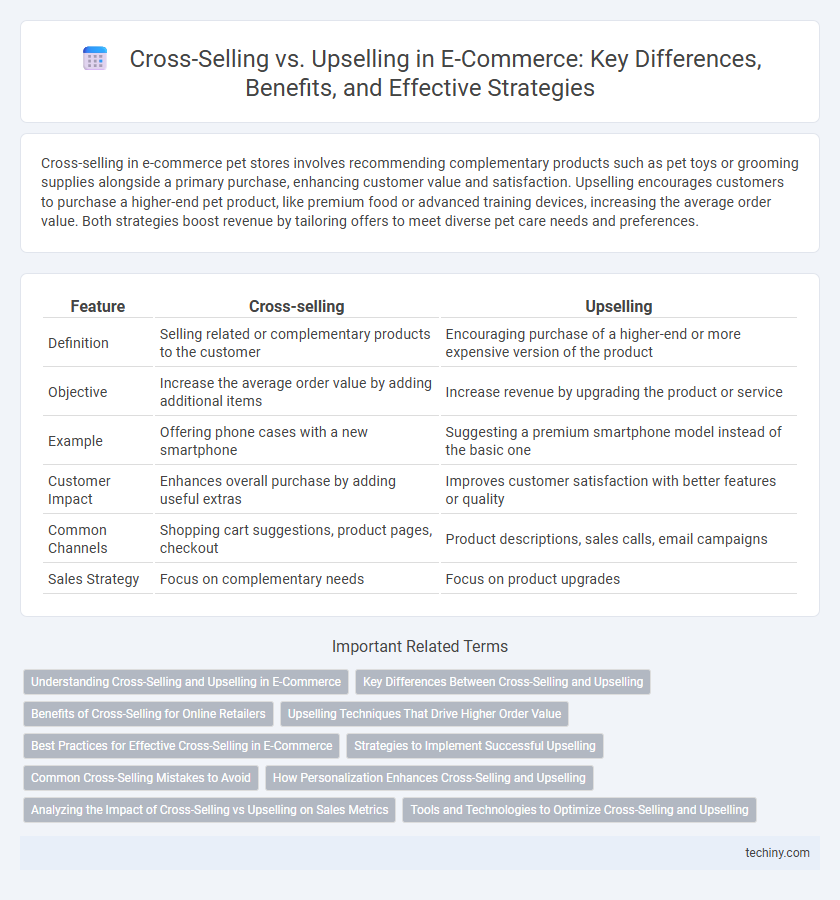Cross-selling in e-commerce pet stores involves recommending complementary products such as pet toys or grooming supplies alongside a primary purchase, enhancing customer value and satisfaction. Upselling encourages customers to purchase a higher-end pet product, like premium food or advanced training devices, increasing the average order value. Both strategies boost revenue by tailoring offers to meet diverse pet care needs and preferences.
Table of Comparison
| Feature | Cross-selling | Upselling |
|---|---|---|
| Definition | Selling related or complementary products to the customer | Encouraging purchase of a higher-end or more expensive version of the product |
| Objective | Increase the average order value by adding additional items | Increase revenue by upgrading the product or service |
| Example | Offering phone cases with a new smartphone | Suggesting a premium smartphone model instead of the basic one |
| Customer Impact | Enhances overall purchase by adding useful extras | Improves customer satisfaction with better features or quality |
| Common Channels | Shopping cart suggestions, product pages, checkout | Product descriptions, sales calls, email campaigns |
| Sales Strategy | Focus on complementary needs | Focus on product upgrades |
Understanding Cross-Selling and Upselling in E-Commerce
Cross-selling in e-commerce involves recommending complementary products to customers, increasing the average order value by encouraging additional purchases beyond the primary item. Upselling focuses on persuading customers to buy a higher-end version or upgrade of the product they intend to purchase, enhancing revenue through premium offerings. Effective implementation of both strategies leverages personalized product suggestions and customer behavior data to optimize sales conversion rates.
Key Differences Between Cross-Selling and Upselling
Cross-selling involves offering complementary products to enhance the customer's initial purchase, while upselling promotes a higher-end version or an upgrade of the same product. Cross-selling increases average order value by encouraging multiple purchases, whereas upselling focuses on increasing the value of a single item. E-commerce platforms leverage personalized recommendations and data analytics to optimize both strategies effectively.
Benefits of Cross-Selling for Online Retailers
Cross-selling enhances customer lifetime value by encouraging buyers to purchase complementary products, increasing average order value and boosting overall revenue for online retailers. It improves customer satisfaction through personalized recommendations that meet broader needs, fostering loyalty and repeat business. Implementing data-driven cross-selling strategies helps optimize inventory management and marketing efficiency while maximizing sales opportunities without additional customer acquisition costs.
Upselling Techniques That Drive Higher Order Value
Upselling techniques that drive higher order value include personalized product recommendations based on customer purchase history, offering premium or upgraded versions of items in the shopping cart, and using scarcity tactics like limited-time offers to create urgency. Implementing AI-driven algorithms can enhance these strategies by analyzing customer behavior to suggest higher-margin products effectively. Clear communication of added benefits and value helps increase average order size and boosts overall revenue in e-commerce platforms.
Best Practices for Effective Cross-Selling in E-Commerce
Implement targeted product recommendations based on customer behavior and purchase history to enhance cross-selling effectiveness in e-commerce. Utilize data analytics to identify complementary products that increase average order value without overwhelming the buyer. Clear visuals and concise product descriptions help customers understand the value of cross-sells, improving overall conversion rates.
Strategies to Implement Successful Upselling
Successful upselling strategies in e-commerce involve personalized product recommendations based on customer behavior and purchase history, increasing average order value. Implement dynamic pricing and limited-time offers to create urgency and encourage customers to choose premium options. Integrate seamless user interface designs that highlight benefits and key differences between standard and upgraded products to facilitate informed decision-making.
Common Cross-Selling Mistakes to Avoid
Common cross-selling mistakes in e-commerce include offering irrelevant products that do not align with the customer's initial purchase, which can lead to cart abandonment and decreased customer satisfaction. Another frequent error is overwhelming customers with too many suggestions, causing decision fatigue and reducing conversion rates. Effective cross-selling requires carefully targeted recommendations based on customer behavior, purchase history, and product compatibility to maximize average order value without negatively impacting the user experience.
How Personalization Enhances Cross-Selling and Upselling
Personalization enhances cross-selling and upselling by analyzing customer behavior and preferences to recommend relevant products, which increases average order value and customer satisfaction. Data-driven algorithms enable e-commerce platforms to deliver targeted product suggestions that resonate with individual purchasing patterns, improving conversion rates. Tailored offers and dynamic pricing strategies create a seamless shopping experience, driving higher engagement and repeat purchases.
Analyzing the Impact of Cross-Selling vs Upselling on Sales Metrics
Cross-selling increases average order value by recommending complementary products, boosting overall revenue and enhancing customer satisfaction through personalized suggestions. Upselling drives higher profit margins by encouraging customers to purchase upgraded or premium versions, improving lifetime customer value and profit per transaction. Analyzing sales metrics reveals that combining both strategies strategically can optimize conversion rates, maximize sales growth, and balance customer acquisition costs effectively.
Tools and Technologies to Optimize Cross-Selling and Upselling
Advanced AI-driven recommendation engines analyze customer behavior and purchase history to optimize cross-selling and upselling strategies, increasing average order value effectively. Integration of CRM systems with machine learning algorithms enables personalized product suggestions at critical touchpoints, enhancing the relevance of offers. Real-time analytics and automated marketing platforms facilitate dynamic pricing and targeted promotions, driving higher conversion rates in e-commerce environments.
Cross-selling vs Upselling Infographic

 techiny.com
techiny.com